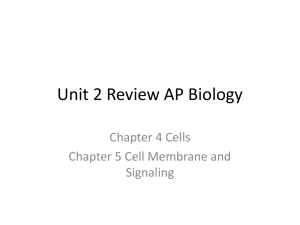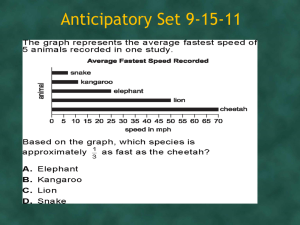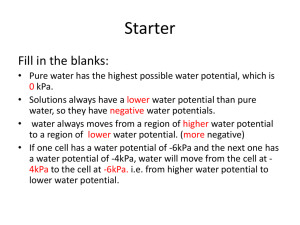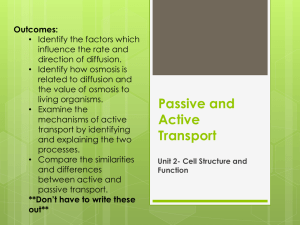The Plasma Membrane: Structure and Function
advertisement
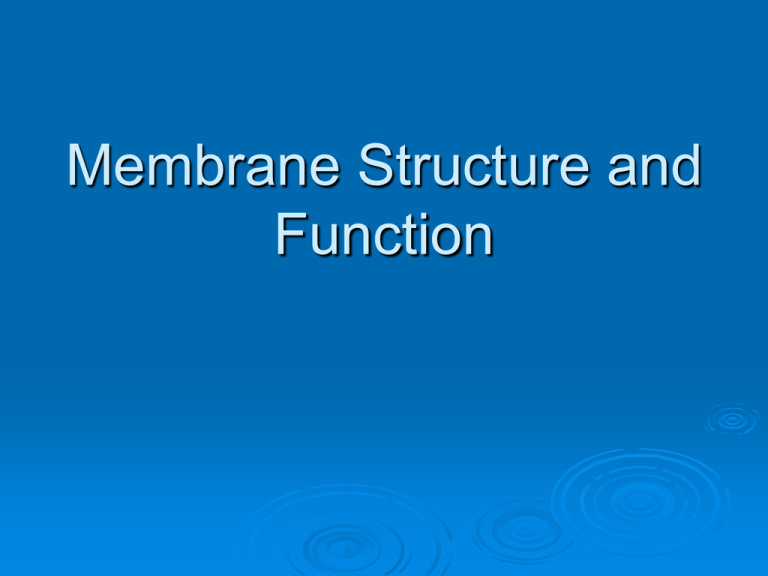
Membrane Structure and Function Membrane Function Membranes organize the chemical activities of cells. The outer plasma membrane forms a boundary between a living cell and its surroundings Exhibits selective permeability • Controls traffic of molecules in and out Membrane Function Internal membranes provide structural order for metabolism • Form the cell's organelles • Compartmentalize chemical reactions Fluid Mosaic Model of the PM A A membrane is a mosaic Proteins and other molecules are embedded in a framework of phospholipids membrane is fluid Most protein and phospholipid molecules can move laterally Membrane Structure Phospholipid Phospholipids are the major structural component of membranes. Membrane Structure All membranes are phospholipid bilayers with embedded proteins. Phospholipid Bilayer Label the: Hydrophilic heads Hydrophobic tails Embedded in the bilayer are proteins Most of the membrane’s functions are accomplished by the embedded proteins. • Integral proteins span the membrane • Peripheral proteins are on one side or the other of the membrane Plasma Membrane Components Glycoproteins and glycolipids are proteins/lipids with short chain carbohydrates attached on the extracellular side of the membrane. Plasma Membrane Types of Membrane Proteins Cell-cell recognition proteins Integrins Intercellular junction proteins Enzymes Signal transduction proteins 1. 2. 3. 4. 5. • 6. Aka - Receptor proteins Transport proteins – Passive and active Cell-cell recognition proteins - identify type of cell and identify a cell as “self” versus foreign Most are glycoproteins • Carbohydrate chains vary between species, individuals, and even between cell types in a given individual. • Glycolipids also play a role in cell recognition Integrins are a type of integral protein The cytoskeleton attaches to integrins on the cytoplasmic side of the membrane Integrins strengthen the membrane Intercellular junction proteins help like cells stick together to form tissues • Many include these as a type of integrin Many membrane proteins are enzymes This is especially important on the membranes of organelles. Signal transduction (receptor) proteins bind hormones and other substances on the outside of the cell. Binding triggers a change inside the cell. • Called signal transduction • Example: The binding of insulin to insulin receptors causes the cell to put glucose transport proteins into the membrane. Fig. 5-1c Messenger molecule Receptor Activated molecule Transport Proteins Passive Transport Proteins allow water soluble substances (small polar molecules and ions) to pass through the membrane without any energy cost Active Transport Proteins The cell expends energy to transport water soluble substances against their concentration gradient Fig. 5-1d Transport Proteins Transport of Substances Across the Plasma Membrane (PM) Passive Transport 1. (Simple) Diffusion (5.3) Facilitated diffusion (5.6) Osmosis (5.4, 5.5) Active Transport (5.8) Bulk Flow (5.9) 2. 3. Endocytosis – 3 types Exocytosis Passive Transport In passive transport substances cross the membrane by diffusion Diffusion - net movement of substances from an area of high concentration to low concentration • no energy required Factors Affecting Diffusion Rate Steepness of concentration gradient Molecular size Steeper gradient, faster diffusion Smaller molecules, faster diffusion Temperature Higher temperature, faster diffusion Simple Diffusion Nonpolar, hydrophobic molecules diffuse directly through the lipid bilayer Simple diffusion does not require the use of transport proteins. Examples: O2, CO2, steroids Polar, hydrophilic substances cannot pass directly through the lipid bilayer Examples: water, ions, carbohydrates Simple Diffusion Polar molecules (ex. Glucose, water) small, nonpolar molecules ions (ex. O2, CO2) (ex. H+, Na+, K+) LIPID-SOLUBLE LIPID-SOLUBLE WATER-SOLUBLE Facilitated Diffusion In facilitated diffusion small polar molecules and ions diffuse through passive transport proteins. No energy needed • Most passive transport proteins are solute specific • Example: glucose enter/leaves cells through facilitated diffusion Facilitated Diffusion Higher concentration of Passive transport protein Lower concentration Osmosis – diffusion of water across a selectively permeable membrane Water moves from an area of _______ water concentration to an area of _____ water conc. Osmosis Is energy required ? Water travels in/out of the cell through aquaporins Osmosis Terms Consider two solutions separated by a plasma membrane. Hypertonic Hypotonic solution with a relatively high concentration of solute solution with a relatively low concentration of solute Isotonic solutions with the same solute concentration Osmosis and Animal Cells Osmosis and Plant Cells Isotonic solution Hypotonic solution H2O H2O H2O Hypertonic solution H2O Animal cell (2) Lysed (1) Normal H2O H2O (3) Shriveled Plasma membrane H2O H2O Plant cell (4) Flaccid (5) Turgid (6) Shriveled (plasmolyzed) Osmosis Practice When a Cell is Placed in a Hypotonic Solution Water concentration is _________ the cell. Water flows ___________ the cell. Osmosis When a Cell is Placed in a Hypertonic Solution Water concentration is _________ the cell. Water flows ___________ the cell. Osmosis Summary When Cell gains water through osmosis Animal cell lyses; plant cell becomes turgid (firm) When a cell is placed in a Hypotonic solution: a cell is placed a Hypertonic solution: Cell loses water through osmosis Animal cell shrivels; plant cell plasmolyzes Active Transport Active transport proteins move substances across the PM against their concentration gradient. Requires energy (ATP) Active transport proteins are highly selective Active transport is needed for proper functioning of nerves and muscles Open to page 78 Active Transport of “X” Active transport proteins span the plasma membrane – They have openings for “X” on only one side of the membrane (1) “X” enters the channel and binds to functional groups inside the transport protein. (2) Cytoplasmic ATP binds to the protein and transfers a P group to the transport protein - protein is energized by the added –P. Active Transport of “X” – (3) The energized transport protein changes shape and releases “X” on the other side of the cell. – (4) The phosphate group is released from the transport protein and it resumes its original shape. – Process repeats. Fig. 5-8-1 Transport protein Solute 1 Solute binding Fig. 5-8-2 Transport protein Solute 1 Solute binding 2 Phosphorylation Fig. 5-8-3 Transport protein Protein changes shape Solute 1 Solute binding 2 Phosphorylation 3 Transport Fig. 5-8-4 Transport protein Protein changes shape Solute 1 Solute binding 2 Phosphorylation 3 Transport Phosphate detaches 4 Protein reversion Active Transport tell the story… ATP P ADP http://www.mhhe.com/biosci/bio_animations/ 05_MH_MembraneTransport_Web/index.ht ml http://www.youtube.com/watch?v=2UPqLmuDnI Bulk Flow (5.9) Vesicles are used to transport large particles across the PM. Requires energy Types: Exocytosis Endocytosis • Phagocytosis, pinocytosis, receptor-mediated Bulk Flow Exocytosis Cytoplasmic vesicle merges with the PM and releases its contents Example: • Golgi body vesicles merge with the PM an release their contents • How nerve cells release neurotransmittors Exocytosis Fluid outside cell Vesicle Protein Cytoplasm Endocytosis Endocytosis PM sinks inward, pinches off and forms a vesicle Vesicle often merges with Golgi for processing and sorting of its contents Endocytosis Vesicle forming Endocytosis can occur in three ways • Phagocytosis ("cell eating") • Pinocytosis ("cell drinking") • Receptor-mediated endocytosis Endocytosis - terms Phagocytosis Membrane sinks in and captures solid particles for transport into the cell Examples: • Solid particles often include: bacteria, cell debris, or food Pinocytosis – cell eating – cell drinking Cell brings in a liquid Endocytosis - comments Phagocytosis and pinocytosis are not selective Membrane sinks inward and captures whatever particles/fluid present. Vesicle forms and merges with the Golgi body… Fig. 5-9, pg 79 Phagocytosis EXTRACELLULAR FLUID CYTOPLASM Pseudopodium Food being ingested Phagocytosis “Food” or other particle Food vacuole Pinocytosis Plasma membrane Pinocytosis Vesicle Plasma membrane Receptor-mediated endocytosis Coat protein Receptor Receptormediated endocytosis Coated vesicle Coated pit Coated pit Specific molecule Material bound to receptor proteins Receptor Mediated Endocytosis Receptor Mediated Endocytosis is a highly specific form of endocytosis. Receptor proteins on the outside of the cell bind specific substances and bring them into the cell by endocytosis Receptor Mediated Endocytosis 1. 2. Receptor proteins on PM bind specific substances (vitamins, hormones, LDL..) Membrane sinks in and forms a pit – Called a coated pit 3. Pit pinches closed to form a vesicle around bound substances • Cytoskeleton aids in pulling in the membrane and vesicle formation Plasma membrane Receptor-mediated endocytosis Coat protein Receptor Coated vesicle Coated pit Coated pit Specific molecule Material bound to receptor proteins Endo and exocytosis video Another animation




